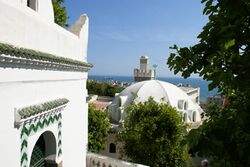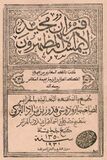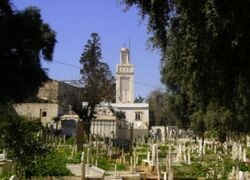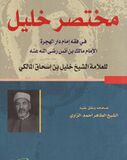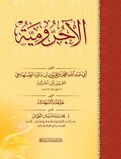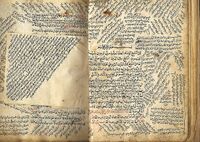Zawiyas in Algeria
Topic: Religion
 From HandWiki - Reading time: 7 min
From HandWiki - Reading time: 7 min
The Zawiyas in Algeria are religious buildings located in Algeria honoring the memory of patron saints and dedicated to Quranic and religious education. They are affiliated with Sufi Torouq brotherhoods under the supervision of the Ministry of Religious Affairs and Endowments in accordance with the precepts of the Algerian islamic reference.[1][2]
History
The history of the zawiyas in Algeria is linked to that of the Sufi or Tourouq brotherhoods which merge with the Sufism which was their inspiration and founder.[3]
It was with the advent of the fifteenth century that the movement to create these spiritual retreats intensified with the decline of the Muslim world in the Machrek as in the Maghreb.[4]
The large Muslim cities lost their scientific and spiritual influence when the last Muslim dynasties lost educational and initiatory control over the mass of Muslim faithful due to the fragmentation of territories between rival emirates.[5]
The current Algerian territory was thus torn between two Berber Muslim dynasties that were the Zianid kingdom of Tlemcen to the west and the Hafsid dynasty of Tunis to the east.[6]
Religious education in the Maghreb was then concentrated in Fez in the Al Quaraouiyine mosque, and in the Great Mosque of Kairouan.[7]
As for the central part bordering the two dynasties Zianide and Hafside, it saw its great intellectual centers in Cherchell and Béjaïa being reduced to their simplest formal expression.[8]
To save Quranic teaching in this conflicting central Maghreb, which later became Algeria, the village customary authorities took charge of safeguarding the Muslim cult by erecting zawiyas in each confederation of tribes.[9]
Scholarly students were selected at the end of the fourteenth century and the beginning of the fifteenth century, after preliminary local Quranic studies, they were then sent to the Al-Azhar mosque in Egypt, passing either through Fez or Kairouan, to perfect their skills and doctrinal training.[10]
The return of these hundreds of Maghrebian theologians after a journey of several years of study in the Machrek, and their installation in the Eastern Zianid and Western Hafsid villages, allowed the creation of the Zawiyas which perpetuated the Muslim influence despite the civilizational decline that then fell on the south of the Mediterranean basin.[11]
The advent of the reconquista and the massive exodus of Andalusian Moors, towards the coast and the coastal urban centers of the Maghreb, brought with them a version of Muslim mystic inherited from Ibn Arabi and Abdul Qadir Gilani which became embedded in the landscape of Maghrebian Sufism.[12]
This is how the Qadiriyya tariqa spread across the central Maghreb and saw the emergence of notable theologians and ascetics like Sidi Abd al-Rahman al-Tha'alibi who had his Zawiya Thaalibia built next to Thaalibi Mosque in the Casbah of Algiers.[13]
Quran recitation
The Quran is the main subject taught in each zawiya in Algeria where the reading of the Quran is done according to the canonical method of Warsh recitation, by way of Al-Azraq and Al-Isfahani (death 908 CE), which is assumed in this religious institution.
Before the advent of modern mechanized printing, Algerian zawiyas relied on manuscripts of the Quran for the reading and recitation of verses and suras, but the founding of the Thaalibia Publishing in 1895 for the first time made it possible to produce the Thaalibia Quran written with the Maghrebi script, and this Mus'haf was used until 1979 as the official Mus'haf of the zawiyas in particular and of the Algerians in general.
The burgeoning popularity of the Kufic script for transcribing the Arabic language into Algerian textbooks forced zawiyas and mosques to produce a printed version of the Quran in 1979 named Algeria Quran according to this Kufic script.
Teachings
Several Islamic sciences are taught in the Algerian zawiyas, as the Hadith which is taught on the basis of Al-Muwatta compiled by Imam Malik ibn Anas.
This is how the fiqh according to the Malikite Madhhab is observed in the courts of each zawiya which is based on the body of the Mukhtasar Khalil written by Khalil ibn Ishaq al-Jundi.
Another reference of the Malikite fiqh dispensed in this zawiya is the Risala fiqhiya written by Ibn Abi Zayd al-Qayrawani.
A third Malikite fiqh reference inculcated in this zawiya is Matn Ibn Ashir written by Abdul Wahid Ibn Ashir.
The Arabic language is taught on the basis of the text of the Al-Alfiyya of Ibn Malik composed by Ibn Malik.
The syntax of the Arabic language is taught on the basis of the text of the Al-Ajurrumiyya composed by Ibn Adjurrum.
The teaching of this same syntax is based on the text of Qatr al-Nada composed by Ibn Hisham al-Ansari.
Idjazates
The talibe receives in the zawiya a certificate called Idjaza at the end of each level of his teaching to certify his pedagogical success.
This Idjaza, in addition to opening the talibe the professional doors of recruitment in the sector of religious affairs as mudaris or muezzin or imam, allows him to be gratified in the Sufi Tariqa with a Sanad level in the Silsila of the Shuyukhs.
Ceremonies
The zawiyas, as popular religious institutions, participate in social life through activities combining the spiritual with the festive.
Thus the daily and periodic collective recitation of the Quran such as the Hizb Rateb and the Salka is at the center of the activity of each zawiya.
The ceremonies linked to the Mawlid and to the memory of the ancient Sufis in the Haḍra and the Ziyarat are also part of the social activities of these Quranic schools.
Other social festivals with religious connotations see the participation of the zawiyas in their organization and joviality such as the Ashura, the Sebiba, the Tweeza, the Wezeea and the Mawsim.
Tariqas
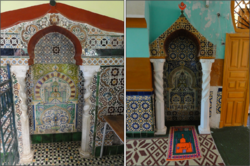
Each one of the Algerian Zawiyas is affiliated to a Sufi Tariqa among:[14][15][16]`
Zawiyas
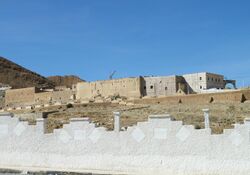
More than 1600 Zawiyas were existing in Algeria before its independence in 1962, among them:[38][39][40]
- Zawiya Thaalibia in Algiers.
- Zawiya Thaalibia in the Issers.
- Zawiyet Sidi Amar Cherif in Sidi Daoud.
- Zawiyet Sidi Boumerdassi in Tidjelabine.
- Zawiyet Sidi Boushaki in Thenia.
- Zawiyet Sidi M'hamed Bou Qobrine in Algiers.
- Zawiyet Sidi M'hamed Bou Qobrine in Bounouh.
- Zawiyet Sidi Saadi in Algiers.
- Zawiyet Sidi Amar in Algiers.
- Zawiya Belkaïdia in Algiers.
- Zawiya Belkaïdia in Oran.
- Zawiyet El Hamel in El Hamel.
- Zawiyet Sidi M'Hamed Saadi in Aafir.
- Zawiyet Sidi Ali Debbaghi in Beni Amrane.
- Zawiyet Sidi Ghobrini in Khemis El-Khechna.
- Zawiyet Sidi Salem in Boudouaou.
See also
References
- ↑ "وزارة الشؤون الدينية والأوقاف". https://www.marw.dz/.
- ↑ قيدار ،الدكتور, قويدر (Jan 1, 2020). دينامية النص الصوفي - بحوث ودراسات في التصوف الإسلامي. Dar Al Kotob Al Ilmiyah دار الكتب العلمية. ISBN 9782745192875. https://books.google.com/books?id=_GT8DwAAQBAJ&pg=PA107. Retrieved Feb 25, 2021.
- ↑ "Les confréries religieuses en Algérie". http://quintessences.unblog.fr/2017/09/24/les-confreries-religieuses-en-algerie/.
- ↑ Sadki, Aziz. "L'état algérien, les zâwiyya et les turûq". http://histoiredelalgerie.over-blog.com/article-l-etat-algerien-les-zawiyya-et-les-turuq-111069703.html.
- ↑ Émerit, Marcel (Feb 25, 1954). "L'état intellectuel et moral de l'Algérie en 1830". Revue d'Histoire Moderne & Contemporaine 1 (3): 199–212. doi:10.3406/rhmc.1954.2576. https://www.persee.fr/doc/rhmc_0048-8003_1954_num_1_3_2576. Retrieved Feb 25, 2021.
- ↑ "Soufisme et zaouïa en Algérie". http://niarunblog.unblog.fr/lalgerie-a-travers-la-presse/le-1er-mai-2009-en-algerie/pour-une-justice-liberee/soufisme-et-zaouia-en-algerie/.
- ↑ "Ces kabyles par qui jure Alger (2). (Sidi M'hamed Bou Qobrine)". Dec 30, 2012. http://kabyleuniversel.com/2012/12/30/ces-kabyles-par-qui-jure-alger-2-sidi-mhamed-bou-qobrine/.
- ↑ "Histoire Jijel : ulema-djidjelli". https://jijel-archeo.123.fr/histoire/index.php?folder=histoire_jijel&page=ulema-djidjelli.
- ↑ Zineb, Abbès (15 May 2011). "Conférence à Adrar sur les zaouïas du Touat et l'importance des manuscrits". https://www.algerie1.com/actualite/conference-a-adrar-sur-les-zaouias-du-touat-et-limportance-des-manuscrits.
- ↑ "Organisation des confréries au sein des zaouias - Tifrit n'Ath Oumalek | 2021". https://www.tifrit.info/village-algerien-kabyle-tifrit-nath-oumalek/48-zaouia/64--organisation-des-confreries-au-sein-des-zaouias?showall=1.
- ↑ "Les Confréries du Sud Algerien". http://kenadsa.e-monsite.com/pages/les-confreries-du-sud-algerien.html.
- ↑ Fkir, Wah (Apr 14, 2014). "Reflexions et Commentaires.: Algérie : La Zaouia Pilier Historique De La Nation Dans Le Collimateur De La CIA Et Du MOSSAD !". https://reflexionsetcommentaires.blogspot.com/2014/04/algerie-la-zaouia-pilier-historique-de.html.
- ↑ hasnaoui, hakim. "Le soufisme algérien à l'époque coloniale". http://ethnopolis-net.over-blog.com/2014/12/le-soufisme-algerien-a-l-epoque-coloniale.html.
- ↑ بليل, عبد الكريم; الاكاديمي, مركز الكتاب (Jan 1, 2018). التصوف والطرق الصوفية. مركز الكتاب الأكاديمي. ISBN 9789957353346. https://books.google.com/books?id=OOfiDwAAQBAJ&pg=PA118. Retrieved Feb 25, 2021.
- ↑ بليل, عبد الكريم; الاكاديمي, مركز الكتاب (Jan 1, 2018). التصوف والطرق الصوفية. مركز الكتاب الأكاديمي. ISBN 9789957353346. https://books.google.com/books?id=OOfiDwAAQBAJ&pg=PA119. Retrieved Feb 25, 2021.
- ↑ "صدور أول موسوعة للصوفية بالجزائر". https://www.aljazeera.net/news/cultureandart/2011/2/17/صدور-أول-موسوعة-للصوفية-بالجزائر.
- ↑ "ملتقى الطريقة الصوفية العلاوية: مستغانم عاصمة للتراث الروحي و الفكر الإصلاحي". https://www.djazairess.com/ennahar/36880.
- ↑ "ص275 - كتاب تاريخ الجزائر الثقافي - الشابية - المكتبة الشاملة الحديثة". https://al-maktaba.org/book/33512/1777.
- ↑ بليل, عبد الكريم; الاكاديمي, مركز الكتاب (Jan 1, 2018). التصوف والطرق الصوفية. مركز الكتاب الأكاديمي. ISBN 9789957353346. https://books.google.com/books?id=OOfiDwAAQBAJ&pg=PA149. Retrieved Feb 25, 2021.
- ↑ مفتاح, عبد الباقي (Jan 1, 2009). أضواء على الطريقة الرحمانية الخلوتية. Dar Al Kotob Al Ilmiyah دار الكتب العلمية. ISBN 9782745161079. https://books.google.com/books?id=sDBxDwAAQBAJ&pg=PA242. Retrieved Feb 25, 2021.
- ↑ بن معمر, محمد (Jun 30, 2004). "مدينة وهران من خلال مخطوط الرحلة الحبيبية الوهرانية". Insaniyat / إنسانيات. Revue algérienne d'anthropologie et de sciences sociales (23–24): 47–60. doi:10.4000/insaniyat.5515. http://journals.openedition.org/insaniyat/5515. Retrieved Feb 25, 2021.
- ↑ الجزائري, الدكتور محمد حاج عيسى. "نبذة عن تاريخ الطرق الصوفية في الجزائر". https://islahway.com/v2/index.php/الأقسام/مقالات-وبحوث-تاريخية/item/543-2014-05-26-16-17-40.
- ↑ "ص84 - كتاب تاريخ الجزائر الثقافي - الطريقة العيساوية - المكتبة الشاملة الحديثة". https://al-maktaba.org/book/33512/1575.
- ↑ "ص88 - كتاب تاريخ الجزائر الثقافي - الكرزازية الأحمدية والزيانية - المكتبة الشاملة الحديثة". https://al-maktaba.org/book/33512/1579.
- ↑ الكوثري, محمد زاهد (Jan 1, 2004). البحوث السنية عن بعض رجال أسانيد الطريقة الخلوتية. Dar Al Kotob Al Ilmiyah دار الكتب العلمية. ISBN 9782745143426. https://books.google.com/books?id=yAFrDwAAQBAJ. Retrieved Feb 25, 2021.
- ↑ بليل, عبد الكريم; الاكاديمي, مركز الكتاب (Jan 1, 2018). التصوف والطرق الصوفية. مركز الكتاب الأكاديمي. ISBN 9789957353346. https://books.google.com/books?id=OOfiDwAAQBAJ&pg=PA129. Retrieved Feb 25, 2021.
- ↑ "الطريقة الناصرية الزيانية بشمال الجزائر – الناصرية". https://www.naciriya.com/%D8%A7%D9%84%D8%B7%D8%B1%D9%8A%D9%82%D8%A9-%D8%A7%D9%84%D9%86%D8%A7%D8%B5%D8%B1%D9%8A%D8%A9-%D8%A7%D9%84%D8%B2%D9%8A%D8%A7%D9%86%D9%8A%D8%A9-%D8%A8%D8%B4%D9%85%D8%A7%D9%84-%D8%A7%D9%84%D8%AC%D8%B2/.
- ↑ 28.0 28.1 بليل, عبد الكريم; الاكاديمي, مركز الكتاب (Jan 1, 2018). التصوف والطرق الصوفية. مركز الكتاب الأكاديمي. ISBN 9789957353346. https://books.google.com/books?id=OOfiDwAAQBAJ&pg=PA128. Retrieved Feb 25, 2021.
- ↑ "بذة عن تاريخ الطّرق الصّوفية في الجزائر". https://essalihine.yoo7.com/t178-topic.
- ↑ بليل, عبد الكريم; الاكاديمي, مركز الكتاب (Jan 1, 2018). التصوف والطرق الصوفية. مركز الكتاب الأكاديمي. ISBN 9789957353346. https://books.google.com/books?id=OOfiDwAAQBAJ&pg=PA143. Retrieved Feb 25, 2021.
- ↑ بليل, عبد الكريم; الاكاديمي, مركز الكتاب (Jan 1, 2018). التصوف والطرق الصوفية. مركز الكتاب الأكاديمي. ISBN 9789957353346. https://books.google.com/books?id=OOfiDwAAQBAJ&pg=PA151. Retrieved Feb 25, 2021.
- ↑ "محمد بن علي السنوسي.. شيخ الصوفية الذي غيّبه العقيد". https://www.djazairess.com/alfadjr/177882.
- ↑ مفتاح, عبد الباقي (Jan 1, 2009). أضواء على الشيخ أحمد التجاني وأتباعه. Dar Al Kotob Al Ilmiyah دار الكتب العلمية. ISBN 9782745160584. https://books.google.com/books?id=9eVhDwAAQBAJ&pg=PA23. Retrieved Feb 25, 2021.
- ↑ بليل, عبد الكريم; الاكاديمي, مركز الكتاب (Jan 1, 2018). التصوف والطرق الصوفية. مركز الكتاب الأكاديمي. ISBN 9789957353346. https://books.google.com/books?id=OOfiDwAAQBAJ&pg=PA144. Retrieved Feb 25, 2021.
- ↑ بليل, عبد الكريم; الاكاديمي, مركز الكتاب (Jan 1, 2018). التصوف والطرق الصوفية. مركز الكتاب الأكاديمي. ISBN 9789957353346. https://books.google.com/books?id=OOfiDwAAQBAJ&pg=PA139. Retrieved Feb 25, 2021.
- ↑ "- نبذة عن تاريخ الطّرق الصّوفية في الجزائر (2)". http://www.nebrasselhaq.com/home/item/1401-%D9%86%D8%A8%D8%B0%D8%A9-%D8%B9%D9%86-%D8%AA%D8%A7%D8%B1%D9%8A%D8%AE-%D8%A7%D9%84%D8%B7%D9%91%D8%B1%D9%82-%D8%A7%D9%84%D8%B5%D9%91%D9%88%D9%81%D9%8A%D8%A9-%D9%81%D9%8A-%D8%A7%D9%84%D8%AC%D8%B2%D8%A7%D8%A6%D8%B1-2.
- ↑ بليل, عبد الكريم; الاكاديمي, مركز الكتاب (Jan 1, 2018). التصوف والطرق الصوفية. مركز الكتاب الأكاديمي. ISBN 9789957353346. https://books.google.com/books?id=OOfiDwAAQBAJ&pg=PA138. Retrieved Feb 25, 2021.
- ↑ طيب, جاب الله ، (Dec 25, 2014). "الطرق الصوفية والزوايا في المجتمع الجزائري : قراءة في سوسيولوجيا الروحانيات الصوفية". Majallat al-Ḥikmah lil-Dirāsāt al-Islāmīyah 224 (5570): 88–106. doi:10.12816/0043331. https://platform.almanhal.com/Details/Article/111867?lang=en. Retrieved Feb 25, 2021.
- ↑ "الطرق الصوفية في الجزائر: بين التأييد والمعارضة". Aug 27, 2009. https://www.echoroukonline.com/الطرق-الصوفية-في-الجزائر-بين-التأييد-و/.
- ↑ "الوجه الحقيقي للزوايا والطرق الصوفية في الجزائر". https://www.djazairess.com/djelfa/2131.
 KSF
KSF